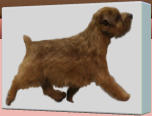

Breeders Corner

Kafka said, "All knowledge, the
totality of all questions and
answers, is contained in the dog."

Please submit your article,
publication or hyperlink to an
article to Judi Hartell.
DataDawg@Austin.rr.com
Submissions

Quote



The Bluebonnet Norfolk Terrier Club does not recommend,
guarantee, endorse, nor rate these recommendations or
contributors, their kennel or their stock. The purpose of this section
is to share the knowledge and experience of breeders who have vast
experience in whelping and raising puppies. The tips and tricks
below are intended to augment qualified veterinarian care, not as a
substitute for qualified veterinarian care of the dam and puppies.





Recessive Traits
HEAD: Pronounced parietal crest and occiput, Large skull size, Short ears, Fine skull, Light
eye, Bulging eye, Overshot/Undershot Bite
BODY: Good shoulder, Angulation, Good stifle angulation, Long, reaching gait, Low tail
set, No feathering on tail, Kinked tail, Long coat, Longer, straight leg (correlates with light
bone)
MENTAL: Mild, non-aggressive temperament, Lack of intelligence
Dominant Traits
HEAD: Low set ears, long ears, long head, wide ear leather, dewlap, dark eye, correct bite,
black nose, short face.
BODY: Sternum, deep chest, straight top line, straight tail, high tail set, good spring of rib,
heavy bone, Achondroplastic short leg with crook (correlates with big bone), compact
foot, short coat, weight, body height, poor shoulder angulation, poor stifle angulation,
short, choppy gait.
MENTAL: Intelligence, shy and/or vicious temperament
Dominant and Recessive Traits
Dog breeders should understand two concepts: (1) aside from coat length and color, the
trits of interest to us are for the most part polygenetic (controlled by many gene pairs),
and (2) polygenetic traits are generally composed of a mixed bag of dominant and
recessive genes. Although research in canine genetics lags behind that of other species,
and some authorities disagree on whether certain traits are indeed dominant or
recessive, there are dominant and recessive traits agreed upon by a majority of
geneticists and breeders (Willis, 1989, Seranne, 1980). Most of these traits are controlled
by numerous gene pairs (polygenetic) and factors such as incomplete dominance and
penetrance. For our purpose, the most important task is to familiarize yourself with the
list in general and make note of traits you wish to improve in your breeding program. We
will publish the list with the next update.


- Behavior
- Honor Roll
- Living With Norfolk Terriers
- Fun With Your Norfolk
- Tip Of The Week
- Publications
- Therapy and Service Dogs
- Health & Nutrition
- Competition


- Books
- Clubs
- Collectibles, Gifts & Fun Activities
- Companion Animal Recovery
- Dog Show Superintendents
- Genetics
- Health Related Sites
- Canine Health Links
- Vaccination Protocols
- Animal Health Trust
- Online Mendelian Inheritance In Animals
- Univ. Of Cambridge Vet. School
- Canine Inherited Disorders Database
- All Creatures Veterinary Hospital
- A First Aid Kit
- Veterinary Pet Insurance
- AKC Pet Health Plan
- Cornell Univ. College of Vet. Medicine
- More Health Related Sites
- Independent Sites
- Pet Travel
- Training Your Puppy
- Publications


- Breeding Tips
- Breeding Tips Page One
- Breeding Tips Page Two
- Breeding Tips Page Three
- Breeding Tips Page Four
- Breeding Tips Page Five
- Breeding Tips Page Six
- Virus &The Pregnant Bitch
- Dog Neutering Video
- Vaccinations & The Pregnant Bitch
- Incontinence In The Pregnant Bitch
- Flagyl & The Pregnant Bitch
- Canine Reproduction
- Frozen vs Chilled Semen
- Modern Breeding Management
- Dialogue On Rasberry Leaves
- Monitoring Pregnancy
- Uses For Vaginal Cultures
- OFA & The Pregnant Bitch
- Breeding Tips Page Seven
- Breeding Tips Page Eight
- Breeding Tips Page Nine
- Breeding Tips Page Ten
- Breeding Tips Page Eleven
- Breeding Tips Page Twelve
- Breeding Tips Page Thirteen
- Breeding Tips Page Fourteen
- Genetics And Inheritance
- Rescue









